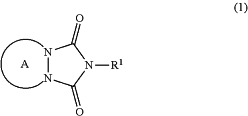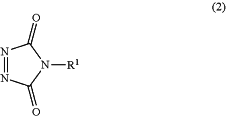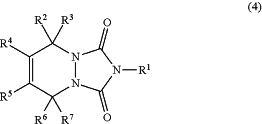| CPC G01N 33/82 (2013.01) [C07D 487/08 (2013.01); G01N 30/06 (2013.01); G01N 2030/067 (2013.01); G01N 2560/00 (2013.01)] | 14 Claims |
|
1. A method for quantifying a diene compound, comprising:
a triazolinedione adduct heating step of heating a triazolinedione adduct represented by formula (1) to produce a triazolinedione compound represented by formula (2);
an ene compound formation step of reacting the triazolinedione compound with a diene compound represented by formula (3) to obtain an ene compound represented by formula (4); and
an ene compound quantifying step of quantifying the ene compound to quantify the diene compound,
 wherein in the formula (1), R1 represents an organic group; and A represents a fused ring having three or more rings comprising at least one aromatic ring,
 wherein in the formula (2), R1 is as defined in the formula (1),
 wherein in the formula (3), R2, R3, R4, R5, R6, and R7 each independently represent a group selected from the group consisting of a hydrogen atom, an alkyl group having 1 to 100 carbon atoms, an aralkyl group, a phenyl group, and a heterocyclic group, wherein the alkyl group, the aralkyl group, the phenyl group, and the heterocyclic group optionally comprise an atom selected from the group consisting of an oxygen atom, a nitrogen atom, a sulfur atom, and a phosphorus atom, and wherein two or more of R2, R3, R4, R5, R6, and R7 are optionally combined with one another, and
 wherein in the formula (4), R1 is as defined in the formula (1); and R2, R3, R4, R5, R6, and R7 are as defined in the formula (3).
|